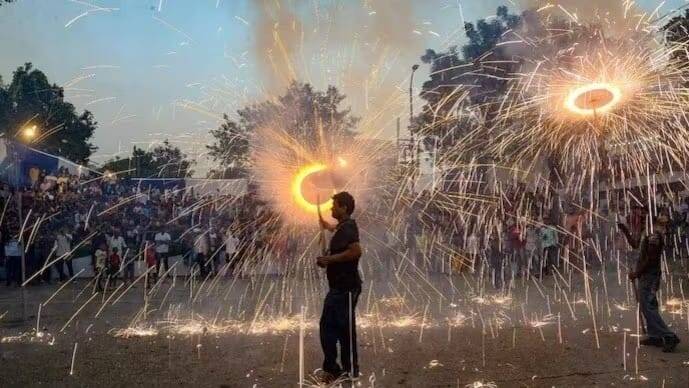Main Points In Hindi (मुख्य बातें – हिंदी में)
-
आर्थिक मंदी का संकेत: भारत की आर्थिक गतिविधियां त्योहारी सीजन के आगमन के साथ धीमी हो गई हैं, जिसमें जीएसटी संग्रह में कमी, विनिर्माण गतिविधियों का गिरना, और घरेलू कारों की बिक्री में लगातार गिरावट शामिल है।
-
त्योहारी सीजन की संभावनाएं: विशेषज्ञ आशावादी हैं कि त्योहारी खरीदारी से आर्थिक मंदी की भरपाई हो सकती है। संभावना है कि ग्रामीण मांग के बढ़ने और उपभोक्ता खर्च में वृद्धि से अर्थव्यवस्था में सुधार आएगा।
-
लग्जरी खर्च का बढ़ना: इस साल उपभोक्ताओं का विलासिता के उत्पादों और अनुभवों पर खर्च बढ़ने की संभावना है, जो उपभोक्ता विश्वास की वापसी को दर्शाता है।
-
ऑटोमोबाइल क्षेत्र की उम्मीदें: नवरात्रि, दशहरा और दिवाली जैसे त्योहारों के चलते ऑटोमोबाइल निर्माता इस सीजन में बिक्री में सुधार की आशा कर रहे हैं, जिसमें बुकिंग में वृद्धि देखी जा रही है।
- आगे का दृष्टिकोण: निजी खपत जो GDP का लगभग 60% हिस्सा है, आगामी महीनों में महत्वपूर्ण रहेगी; त्योहारी सीजन खुदरा और उपभोक्ता वस्तुओं के लिए उछाल का अवसर प्रदान कर सकता है, यदि उपभोक्ता खर्च करते हैं।
Main Points In English(मुख्य बातें – अंग्रेज़ी में)
Here are the main points from the provided text:
-
Slowdown in Economic Activity: India’s economy is experiencing a slowdown as evidenced by declining manufacturing activity, lower GST collections, and a drop in domestic car sales, raising concerns among experts regarding the country’s economic momentum.
-
Potential for Recovery During Festive Season: Despite recent economic challenges, there is cautious optimism that increased spending during the upcoming festive season could help offset the downturn and stimulate much-needed economic recovery.
-
Mixed Signals in Economic Indicators: Recent data indicates a modest increase in GST collections and a drop in manufacturing PMI. Power consumption has stagnated, suggesting a slowdown in industrial activity, yet there are expectations of growth driven by rural demand during the latter half of the year.
-
Consumer Spending Trends: Urban households are expected to spend significantly during the 2024 festivals, with a strong preference for in-store shopping and a rise in luxury expenditures, signaling a resurgence in consumer confidence.
- Automotive Sector Expectations: Auto manufacturers anticipate a rebound in sales during the festive season, with early signs of increased bookings and attractive financing options expected to drive demand, including among luxury car buyers.


Complete News In Hindi(पूरी खबर – हिंदी में)
त्योहारी सीज़न आते ही भारत की आर्थिक गति धीमी हो गई है, जिससे विशेषज्ञ आश्चर्यचकित हैं कि क्या यह वार्षिक खरीदारी उन्माद ठंडी अर्थव्यवस्था में नई जान फूंक सकता है।
महीनों तक, देश ने मजबूत गति का अनुभव किया, लेकिन हाल के आंकड़ों ने अधिक धीमी तस्वीर पेश की है। विनिर्माण गतिविधि में गिरावट आई है, जीएसटी संग्रह में कमी आई है और घरेलू कारों की बिक्री में गिरावट जारी है।
फिर भी, अभी भी उम्मीद की एक किरण है कि त्योहारी सीजन में खर्च में बढ़ोतरी से मंदी की भरपाई हो जाएगी और बहुत जरूरी सुधार आएगा।
अर्थव्यवस्था पर गति की मार पड़ी है
सितंबर में गिरावट स्पष्ट हो गई जब जीएसटी संग्रह मामूली 6.5% बढ़ गया, जो कि वित्तीय वर्ष में पहले देखी गई दोहरे अंक की वृद्धि से काफी कम था।
विनिर्माण ने भी इसका अनुसरण किया, क्रय प्रबंधक सूचकांक (पीएमआई) आठ महीने के निचले स्तर 56.5 पर पहुंच गया।
डीलरशिप द्वारा भारी छूट देने के बावजूद, कार की बिक्री में गिरावट का यह लगातार तीसरा महीना था।
यहां तक कि बिजली की खपत, जो अक्सर औद्योगिक गतिविधि का एक अच्छा माप है, में भी पिछले वर्ष की तुलना में केवल 0.6% की वृद्धि हुई है।
एचएसबीसी में मुख्य भारत अर्थशास्त्री प्रांजुल भंडारी ने इस बात पर प्रकाश डाला कि कैसे तेज गर्मी के बाद विनिर्माण क्षेत्र की गति काफी कमजोर हो गई है। मुख्य बुनियादी ढांचा उद्योगों को भी ठंड का एहसास हुआ, अगस्त में 1.8% की गिरावट आई, जो चार वर्षों में पहली ऐसी गिरावट थी।
उत्सव की खुशियाँ खेल बदल सकती हैं
इन चुनौतियों के बावजूद, मंदी अल्पकालिक हो सकती है। अर्थशास्त्री आशावादी हैं और अनुकूल मानसून और आगामी त्योहारी अवधि को संभावित उछाल के लिए प्रमुख चालक बता रहे हैं।
बैंक ऑफ बड़ौदा के मुख्य अर्थशास्त्री मदन सबनवीस ने द इकोनॉमिक टाइम्स को बताया कि साल की दूसरी छमाही में ग्रामीण मांग बढ़ने की उम्मीद है, जिससे कुल खपत बढ़ेगी।
उन्हें विश्वास है कि भारत अभी भी 7% से अधिक की वृद्धि की राह पर है, उपभोक्ता वस्तुएं विशेष रूप से मजबूत दिख रही हैं।
यह ध्यान देने योग्य है कि भारत मौसम विज्ञान विभाग ने जून-सितंबर मानसून के मौसम के दौरान सामान्य से 7.6% अधिक वर्षा की सूचना दी, जो कृषि के लिए एक वरदान है लेकिन अन्य क्षेत्रों को नुकसान पहुंचा सकता है।
इक्रा की मुख्य अर्थशास्त्री अदिति नायर ने कहा कि सितंबर के कम जीएसटी संग्रह के पीछे भारी बारिश हो सकती है। हालाँकि, वह आशावादी बनी हुई है, यह अनुमान लगाते हुए कि त्योहारी सीजन में अधिक मात्रा और मजबूत राजस्व संग्रह होगा।
बैंक ऑफ बड़ौदा की अर्थशास्त्री सोनल बधान ने इन भावनाओं को दोहराया। उन्होंने कहा कि मूडीज और एसएंडपी सहित कई अंतरराष्ट्रीय संगठनों ने अपने भारत के सकल घरेलू उत्पाद के पूर्वानुमान को संशोधित किया है, मूडीज को अब चालू वित्त वर्ष के लिए 7.2% की वृद्धि की उम्मीद है।
“त्योहार की मांग भी मौजूदा गति को बनाए रखने में मदद करेगी। शहरी मांग, जो हवाई यात्रियों की आवाजाही में परिलक्षित होती है (वित्तीय वर्ष 25 की दूसरी तिमाही में ~97.5 मिलियन बनाम Q1 में 99.8 मिलियन) और सेवा पीएमआई (Q2 में 60 बनाम Q1 में 60.5) भी अपनी पकड़ बनाए हुए हैं। इस प्रकार हम वित्त वर्ष 2015 की वृद्धि (7.3-7.4%) पर अधिकांश संगठनों की तुलना में अधिक आशावादी हैं।”
उत्सव का माहौल कैसा है?
त्योहारों का मौसम परंपरागत रूप से भोग-विलास का समय होता है और इस साल भी कुछ अलग नहीं है।
लोकल सर्कल्स ने एक सर्वेक्षण किया जिसमें पता चला कि शहरी परिवारों द्वारा 2024 उत्सवों के दौरान लगभग 1.85 लाख करोड़ रुपये खर्च करने की उम्मीद है। घर की साज-सज्जा, सुंदरता और फैशन में गहरी रुचि है, और यद्यपि ई-कॉमर्स बढ़ गया है, फिर भी 70% शहरी परिवार अभी भी स्टोर में खरीदारी करना पसंद करते हैं।
विलासिता खर्च भी बढ़ रहा है, उपभोक्ता उच्च-स्तरीय ब्रांडों और अनुभवों पर पैसा खर्च करने के लिए तैयार हैं। छुट्टियों से लेकर प्रीमियम उत्पादों तक, विवेकाधीन खर्च की ओर यह बदलाव एक संकेत है कि उपभोक्ता विश्वास वापसी कर रहा है।
ऑटोमेकर्स को पुनरुद्धार की उम्मीद है
ऑटोमोटिव क्षेत्र विशेष रूप से बदलाव को लेकर आशान्वित है। नवरात्रि, दशहरा और दिवाली नजदीक आने के साथ, वाहन निर्माता हाल के रुझानों को उलटने के लिए इस त्योहारी अवधि पर भरोसा कर रहे हैं। टी
एटीए मोटर्स और मारुति सुजुकी की बुकिंग में पहले से ही बढ़ोतरी देखी जा रही है, और आकर्षक वित्तपोषण विकल्पों के साथ महत्वपूर्ण छूट से मांग बढ़ने की उम्मीद है।
यहां तक कि लक्जरी कार निर्माता भी एक मजबूत सीजन की उम्मीद कर रहे हैं, क्योंकि अमीर उपभोक्ता उत्सव के दौरान खुद को खुश करना चाहते हैं।
आगे क्या छिपा है?
बड़ा सवाल यह है कि क्या त्योहारी खुशियां सचमुच अर्थव्यवस्था को गति दे सकती हैं। निजी खपत, जो भारत की जीडीपी का लगभग 60% हिस्सा है, निरंतर विकास के लिए महत्वपूर्ण है, और आने वाले महीने इसके बारे में बताएंगे।
जबकि हालिया आंकड़े मंदी दिखाते हैं, त्यौहारी सीज़न खुदरा, ऑटोमोबाइल और उपभोक्ता वस्तुओं जैसे क्षेत्रों के लिए वापस उछाल का अवसर प्रस्तुत करता है।
यदि ग्रामीण और शहरी उपभोक्ता अपनी जेबें ढीली करें, तो उत्सव का यह मौसम सिर्फ खुशियां फैलाने के अलावा और भी बहुत कुछ कर सकता है – यह अर्थव्यवस्था को बहुत जरूरी सुधार की ओर भी ले जा सकता है।
Complete News In English(पूरी खबर – अंग्रेज़ी में)
As the festive season arrives, India’s economy has slowed down, leaving experts wondering if this annual shopping frenzy can revive a sluggish economy.
For months, the country enjoyed robust growth, but recent data presents a more subdued picture. Manufacturing activity has declined, GST collections have decreased, and domestic car sales continue to drop.
Nevertheless, there is still a glimmer of hope that increased spending during the festive season will offset the downturn and bring much-needed improvements.
The Economy is Slowing Down
The decline became evident in September when GST collections grew only 6.5%, which is significantly lower than the double-digit growth seen earlier in the fiscal year.
Manufacturing mirrored this trend, with the Purchasing Managers’ Index (PMI) falling to an eight-month low of 56.5.
Despite dealers offering hefty discounts, car sales have seen their third consecutive month of decline.
Even electricity consumption, often a good indicator of industrial activity, registered only a 0.6% increase compared to last year.
Pranjul Bhandari, Chief India Economist at HSBC, pointed out that the manufacturing sector’s momentum weakened considerably after intense heat. Major infrastructure industries also felt the cold, experiencing a 1.8% drop in August, marking the first such decline in four years.
Festive Cheers Could Change the Game
Despite these challenges, the downturn may be short-lived. Economists are optimistic and cite favorable monsoons and the upcoming festive period as key drivers for a potential recovery.
Madan Sabnavis, Chief Economist at Bank of Baroda, told The Economic Times that rural demand is expected to rise in the second half of the year, boosting overall consumption.
He believes India is still on track for over 7% growth, particularly in consumer goods.
Notably, the India Meteorological Department reported 7.6% more rainfall than normal during the June-September monsoon season, benefiting agriculture but potentially harming other sectors.
Aditi Nair, Chief Economist at ICRA, suggested that heavy rains could explain the lower GST collections in September. However, she remains optimistic, forecasting higher volumes and strong revenue collections during the festive season.
Sonal Bhadania, an economist at Bank of Baroda, echoed these sentiments. She noted that several international organizations, including Moody’s and S&P, have revised their GDP forecasts for India, with Moody’s now expecting a 7.2% growth for the current fiscal year.
“The festive demand will also help sustain the current momentum. Urban demand, reflected in air travel (around 97.5 million in Q2 versus 99.8 million in Q1) and service PMI (60 in Q2 versus 60.5 in Q1), is also holding steady. Thus, we are more optimistic about growth in FY25 (7.3-7.4%) compared to most organizations,” she stated.
What’s the Festive Mood Like?
The festive season is traditionally a time for indulgence, and this year is no different.
A survey by LocalCircles found that urban households are expected to spend around ₹1.85 lakh crore during the 2024 festivities. There is a strong interest in home decor, beauty, and fashion, and while e-commerce has grown, 70% of urban families still prefer shopping in stores.
Luxury spending is also on the rise, with consumers willing to spend money on high-end brands and experiences. This shift towards discretionary spending, from holidays to premium products, indicates that consumer confidence is returning.
Automakers Are Hopeful for a Revival
The automotive sector is particularly optimistic about the changes. With Navratri, Dussehra, and Diwali approaching, vehicle manufacturers are counting on this festive period to reverse recent trends.
Bookings for companies like Tata Motors and Maruti Suzuki have already shown an increase, and demand is expected to grow with attractive financing options and significant discounts.
Even luxury car manufacturers anticipate a strong season, as affluent consumers seek to indulge themselves during the festivities.
What Lies Ahead?
The big question is whether festive spending can truly revitalize the economy. Private consumption, which accounts for about 60% of India’s GDP, is crucial for sustained growth, and the coming months will reveal more about this trend.
While recent data shows a downturn, the festive season presents an opportunity for sectors like retail, automobiles, and consumer goods to rebound.
If both rural and urban consumers loosen their wallets, this festive season could do more than just spread joy – it could also lead the economy towards much-needed recovery.




